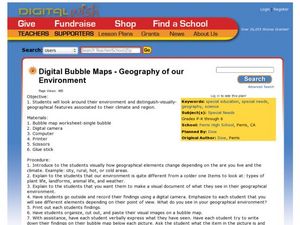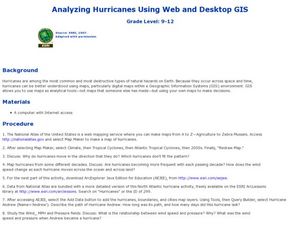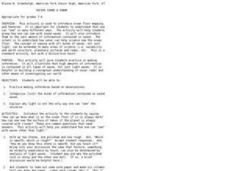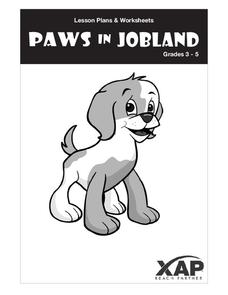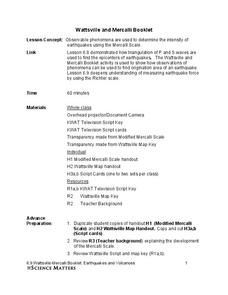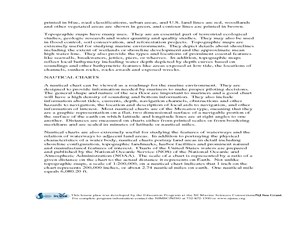Columbus City Schools
Thinking Like A Soil Scientist
Ready to roll up those sleeves and get your hands dirty? Dirty with soil science content, that is! Overcome those "But it's just dirt" objections with a trip outside to collect soil samples for some in-class analysis. Use the...
Science Matters
Finding the Epicenter
The epicenter is the point on the ground above the initial point of rupture. The 10th lesson in a series of 20 encourages scholars to learn to triangulate the epicenter of an earthquake based on the arrival times of p waves and s...
Curated OER
Where in the World Am I?
Students participate in mapping activities to explore an area from different spatial perspectives. In this mapping lesson, students define the terms needed to understand a map. Students use representations such as a balloon and a...
Curated OER
Geography of Our Environment
Students explore geographical elements. For this geographical elements lesson, students create a map showing the geographical elements in their area. Students take pictures of these elements to glue to their map and present it to the class.
Curated OER
Analyzing Hurricanes Using Web and Desktop GIS
Learners analyze hurricanes. In hurricanes lesson, students use the Internet and GIS to analyze hurricanes. Learners view the National Atlas of Maps to discuss the direction hurricanes move. Students study the wind and pressure fields to...
Curated OER
Ecozones Project
Students examine, detail and produce a display about a particular ecozone in Canada. They produce a detailed wall map, written report and a summary sheet.
Curated OER
Elements of Civilization
Young scholars create their own ancient civilizations based off of topographical maps of Egypt, Mesopotamia, the Indus Valley, and the Yellow River. In this social studies lesson plan, students are assigned one topographical map to use...
Curated OER
Seeing Sound & Sonar
Learners make inferences based on different sounds that they hear. In this inferences lesson plan, students will hear sounds of different objects and describe the sounds based on what they hear. They will answer various questions about...
Curated OER
Land Use Worksheet
In this environment learning exercise, students find the solutions to a real life case study after separating into different groups. There is also information about types of land use for scaffolding of the project.
Curated OER
Plate Tectonics Lab
In this plate tectonics worksheet, students cut out plates given a map of the world. They construct an accurate model of the tectonic plates and answer questions about plate tectonics. They also color a map of the world to show the...
Curated OER
Names and Places
Students explore where jobs are done. In this careers and geography lesson, students locate places in Canada on a map and list jobs that are done in their area of Canada. Lesson includes extension and differentiation ideas.
Curated OER
The Transformation and Use of Different Types of Energy Using Local Flora and Fauna in a Vietnam Village Setting
Eighth graders examine the concept that the sun is the ultimate source of energy for living things. They conduct an experiment in which they roast marshmallows over a flame that has been produced from methane gas, which originates from...
Science Matters
Wattsville and Mercalli Booklet
There has been an earthquake! Can you listen to the description of damage given by callers in order to determine the epicenter? The 11th of 20 lessons has pupils read a script of one emergency caller. The class records the information on...
Curated OER
Neither Wind Nor Rain
Here is another in the interesting series of lessons that use the special State Quarters as a learning tool. This one uses the North Dakota State Quarter. During this lesson, your class learns about the different patterns of erosion, and...
National Wildlife Federation
Get Your Techno On
Desert regions are hotter for multiple reasons; the lack of vegetation causes the sun's heat to go straight into the surface and the lack of moisture means none of the heat is being transferred into evaporation. This concept, and other...
Curated OER
Folk and Popular Culture
Good enough for a college class, this resources discusses multiple aspects pertaining to the issues with globalization and the differences between pop and folk culture. It defines major terminology, provides concrete examples, and...
NOAA
Sediments
Calcareous ooze ... what an interesting name! The 15th installment of a 23-part NOAA Enrichment in Marine sciences and Oceanography (NEMO) program focuses on sediments found on the ocean floor. After viewing the slideshow lecture,...
Curated OER
Navigation Across the Seas
Students examine nautical navigation and discover the differences between nautical charts and other types of maps or charts. Students practice setting a course, taking a bearing, and dead reckoning. This gives students an example of...
Curated OER
Geography of the Harbor
Young scholars study estuaries and their boundaries. For this investigative lesson students locate an estuary on a map and use nautical and topographical maps.
Chicago Botanic Garden
Seed Dispersal and Plant Migration
There are five methods of seed dispersal. They include gravity, mechanical, animal, water, and air. Scholars study seed dispersal in lesson five of the series of six. Through discussions, hands-on analysis of different seed types, and...
Curated OER
Using Graphic Organizers to Generate Genre Definitions
Learners listen to or read a variety of stories and then work individually or in groups to complete graphic organizers that will help them focus on elements within different types of stories. They write definitions for a variety of story...
Curated OER
How Many Days To America?
Fourth graders determine how many different types of immigrant groups came to America. They discuss how immigrants feel when moving to a new place. They read the story, "How Many Days to America" by Eve Bunting and discuss how some...
Curated OER
Diatom Ooze
Learners explore seafloor sediment. In this ocean environment instructional activity, students describe the characteristics of different types of seafloor sediment and oozes. They compare and discuss locations of sediments and oozes by...
Center for Learning in Action
Investigating Physical and Chemical Changes
Super scientists visit ten stations to predict, observe, and draw conclusions about the physical and chemical changes that occur when different states of matter—liquid, solid, and gas—are placed under a variety of conditions. To...



